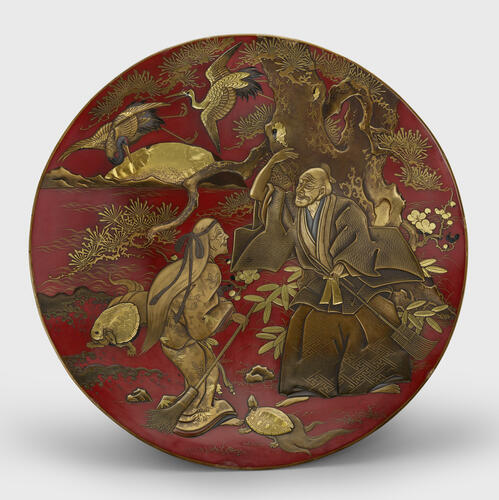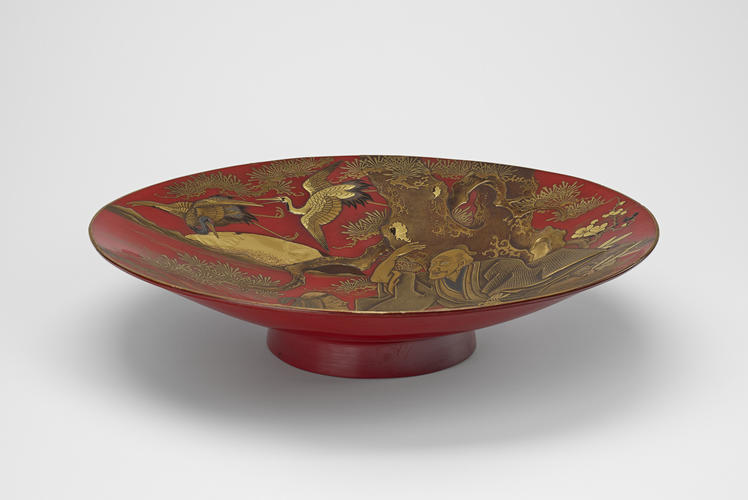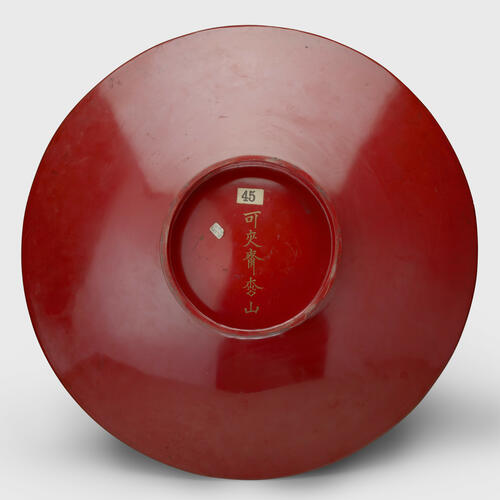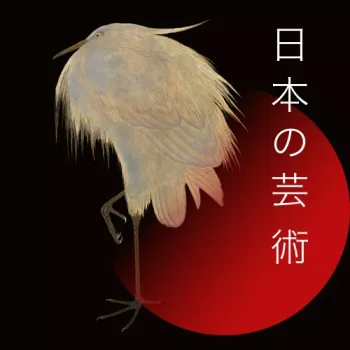Cup for saké (sakazuki) before 1865
Wood, red, gold and silver lacquer | 13.0 x 56.0 x 56.0 cm (whole object) | RCIN 26154
-
The elderly couple on this red lacquer cup represent longevity and conjugal harmony. They are Jō and Uba, who after a long and happy marriage came to dwell in spirit form in two ancient pine trees – one at Takasago in Hyōgo and one at Sumiyoshi in Osaka. According to a Nō adaptation of the legend by Zeami Motokiyo (1363–1443), the pair are reunited on moonlit nights at Takasago Beach. Despite their age, they greet one another exuberantly. The meeting was a popular subject among print artists, including Katsushika Hokusai. In this composition, the couple appear in takamakie (lacquer in high relief ) surrounded by symbols of longevity such as cranes and seaweed-covered tortoises. The figures hold a broom and rake for sweeping the needles of the pine tree, which remains evergreen even in the harshest of winters.
Envoys of Shimazu Tadayoshi of Kagoshima (1840–97) brought this dish to Britain in 1865 ‘as a sign that … cause for enmity was removed’. Conflict had erupted between the Satsuma domain and British forces two years previously, after the Japanese failed to pay reparations for the murder of an Englishman, Charles Richardson, at Namamugi near Yokohama. According to a note received by Sir Charles B. Phipps, Queen Victoria’s unofficial private secretary, ‘it was the custom in Japan, when peace was made between persons who had been at enmity and had fought, for the vanquished person to offer a bowl to his adversary’. The cup is an oversize sakazuki (cup for saké). Queen Victoria was in Coburg for much of the envoys’ visit, so the vessel was delivered to the Foreign Office for safekeeping. It was probably presented by Matsuki Kōan (1832–98), who had been taken captive by the British during the 1863 conflict. He subsequently led a group of 15 Satsuma students who travelled illegally to Britain to learn from their recent adversaries.
Text adapted from Japan: Courts and Culture (2020)Provenance
Sent to Queen Victoria by Prince Satsuma, daimyō of Satsuma domain, 'as a token of submission after his defeat at Kagosima [Kagoshima]' in 1865.
According to a letter from the Foreign Office to Charles B. Phipps, unofficial Private Secretary to the queen, 'When Prince Satsuma's envoys came to England last summer [1865] they bought with them a Japanese bowl which the Prince had sent as an offering to The Queen. They explained to me that it was the custom in Japan, when peace was made between persons who had been at enmity and had fought, for the vanquished person to offer a bowl to his adversary as a sign that the cause for enmity was removed and that he accepted his defeat. Satsuma's stronghold having been destroyed by H.M. Fleet and peace having been restored, the Prince was desirous of presenting this bowl, said to be early and much esteemed Japanese workmanship, to the Queen according to the Japanese custom. Her Majesty being at the time absent from England, Lord Russell authorised me to receive the bowl and to seek Her Majesty's pleasure about it on her return to England this year...' (RA/PPTO/QV/MAIN/1866/20768).
Conflict erupted between the Satsuma domain and British forces in 1863 when the Japanese failed to pay reparations demanded by the British following the murder of an Englishman, Charles Richardson, at Namamugi.
Recorded in the Upper Corridor of the Main Wing at Osborne in 1876 (1876 Inventory, no.862, p.342) and later in the Chinese Chippendale Room at Buckingham Palace. -
Creator(s)
(lacquer maker)(nationality)Acquirer(s)
-
Medium and techniques
Wood, red, gold and silver lacquer
Measurements
13.0 x 56.0 x 56.0 cm (whole object)
Category
Place of Production
Japan











